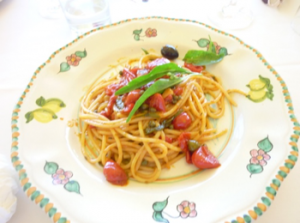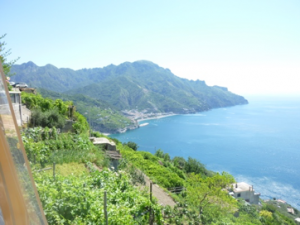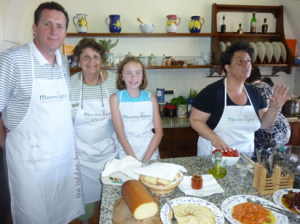(7/31/19)
Warm Spaghetti Pasta with Basil Leaves
Cherry red are the tangy tomatoes,
dark green are the rich basil leaves,
bright yellow are the sour lemons,
we pluck them from the garden below.
Mamma Agata gently takes the handmade thinly sliced noodles,
she carefully boils them in hot water.
Even portions for all to indulge,
plates rest on the long wooden table,
looking out to the marvelous blue coast.
Eyes closed, every sensation enhanced.
The chewy, glistening deliciousness,
like feeling of goosebumps on my tongue.
Seeing the vibrant faces of the other families surrounding,
and the familiar, warm face of my Noni,
smiles stretch as far as the blue coast.
Holding on to this rich feeling,
to share at home with friends and family, alike.
Five thousand miles away from my place of comfort,
and yet here I sit, with not a worry in my mind.

(A picture of the dish)
 (The blue Amalfi coast with Mamma Agata’s garden below)
(The blue Amalfi coast with Mamma Agata’s garden below)

(My father, Noni and I next to Mamma Agata’s daughter)
- What piece did you choose to imitate?
The poem that I chose to imitate was “Cold Noodle Soup with Sophora Leaves” written by Du Fu.
- Why did you choose this piece?
Du Fu’s “Cold Noodle Soup with Sophora Leaves” stood out to me while reading our weekly assignments. Even though this poem was written in the 700s, the style and language Du Fu employs remains relatable to people of all cultures, today. Du Fu richly describes and tells the noodle story which allows the reader to visualize the story, dish, and even sense the taste of the dish, as if they were there with Du Fu experiencing this for themselves. This rich, descriptive style appeals to me, so I decided to imitate it with a noodle dish from my Italian cultural background and experience.
- What did you learn about the culture of the original author through imitating his or her style?
In our recent class discussion Dr. Li explained how presentation and harmonizing flavors are important in Chinese cuisine, treating cuisine as an artform. Du Fu’s poem is a perfect example of this, balanced and harmonized. Though I have not tried this cold noodle dish, the way that Du Fu describes the dish allows me to imagine this flavorful, artistic cuisine. Further, throughout all of our readings and class discussions, we have learned about the important role food plays in connecting people together. In his poem, Du Fu shares how people of all social status (commoners, upper class and royalty) can enjoy the same noodle dish. My speculation is that the commoners are the people he is eating with, the upper class are in the Brocade Lodge and at the end he mentions the royalty. In a way, he is using the noodle to connect people together.
- What did you learn about your own culture while writing?
While reading Du Fu’s poem, it reminded me of the time I traveled to Italy with my Noni and father. It allowed me to reminisce about the time we visited Mamma Agata’s kitchen and cooking class where we cooked an authentic Italian noodle dish. One thing I learned about my own culture is that Italian cooking is an art as well. The way Mamma Agata made the dish was like watching an artist paint. Even though the kitchen was left as a mess after the meal was made, the dish looked amazing and our hungry eyes needed to feast on the masterpiece in front of us. Another revelation is that family and gathering people together over food is a huge part of our Italian culture. Mamma Agata brought strangers together in a room to eat and chat the day away while feasting and bonding over delicious, authentic Italian food.
- Is there cultural DNA embedded in the piece you read and in your piece? How does this DNA manifest in the texts?
In his poem, Du Fu includes three specific lines centered around sharing this dish with other people from all walks of life. The three quotes are “I urge others, offering them like pearls.” ; “galloping off to serve this in the Brocade Lodge” ; “the ruler is enjoying the cool.” Du Fu imbeds cultural DNA by using these lines to connect people of all classes together via this noodle dish, which is a core principle of Chinese cuisine culture. Similarly, I include Italian cultural DNA in my piece specifically the Italian way of using food to connect with people and show love. Towards the end of my poem, I explain the love and connection I felt sitting around Mamma Agata’s table. She wanted to share her dish with everyone around her and spread her love of food to us, and for us to share that love with other people outside of her kitchen.
